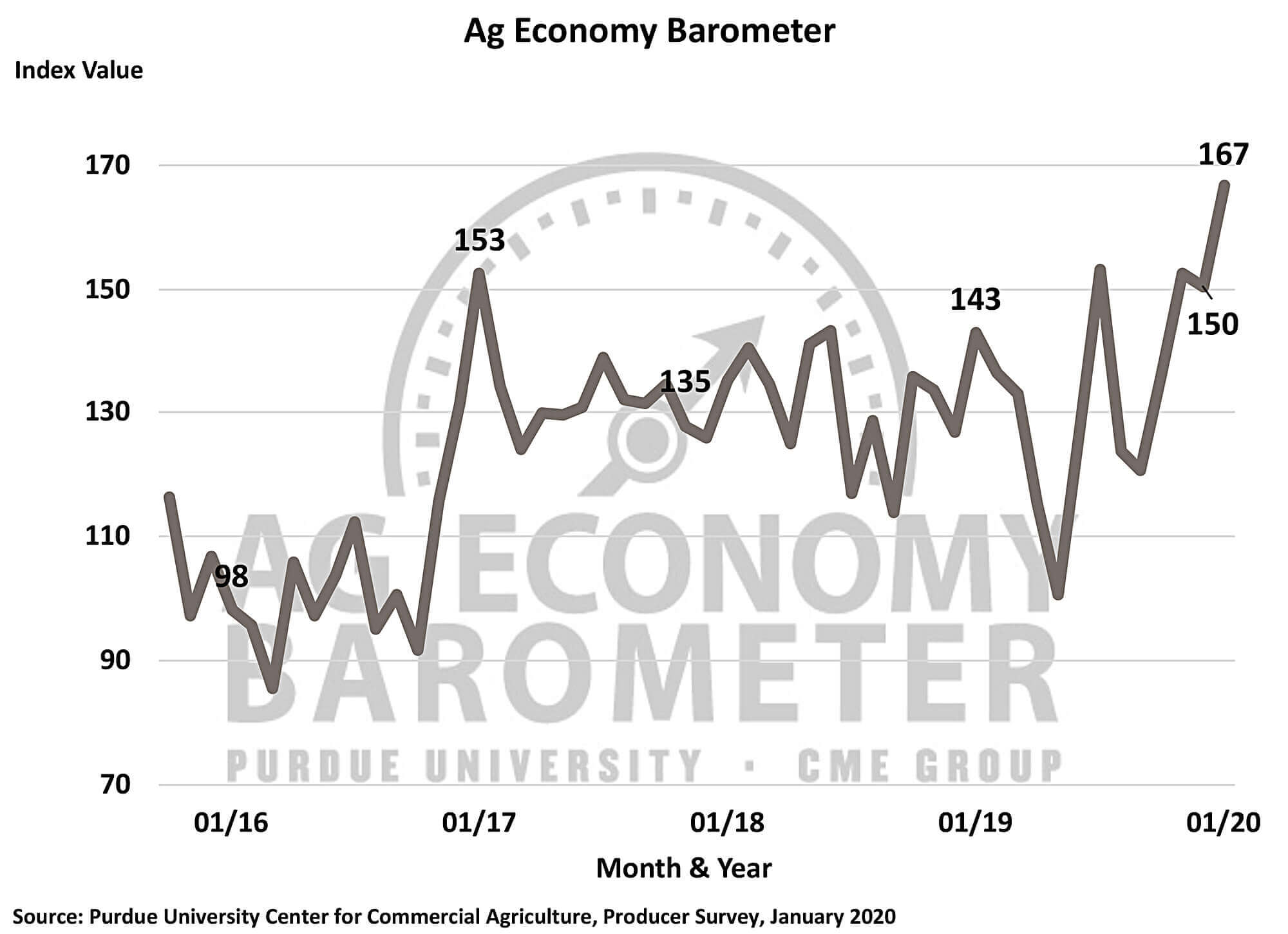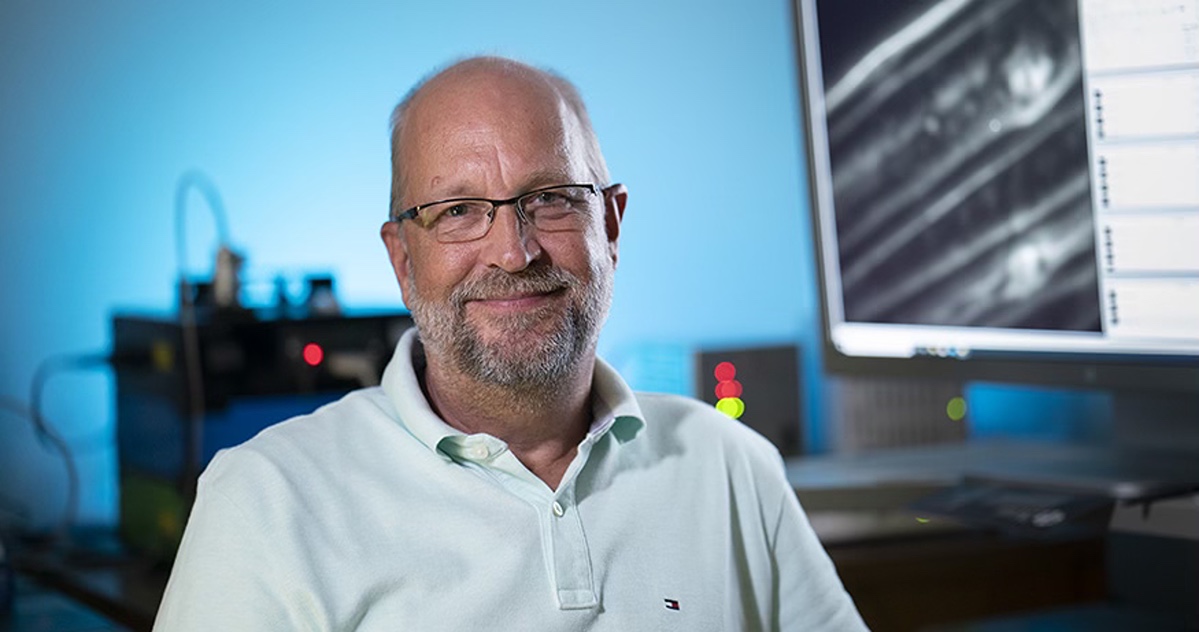Expectations for improved trade with China sends farmer sentiment soaring
There was a sharp rise in agricultural producer sentiment in January as the Purdue University/CME Group Ag Economy Barometer rose 17 points from December to a reading of 167. Although the Index of Current Conditions was essentially unchanged, up one point to a reading of 142, the Index of Future Expectations jumped significantly, up 24 points since December to a reading of 179. The sentiment improvement took place as the Phase One Trade Agreement between the U.S. and China was being discussed and signed in mid-January. The Ag Economy Barometer is based on a mid-month survey of 400 U.S. agricultural producers and was conducted from January 13-17, 2020.
“The Phase One Trade Agreement has largely been considered a win for U.S. exporters, although few details are available regarding how the additional $200 billion in purchases by China will be distributed over the next two years and how much impact it will have on the U.S. farm sector,” said James Mintert, the barometer’s principal investigator and director of Purdue University’s Center for Commercial Agriculture.
One topic that was not directly addressed in the Phase One agreement was the soybean trade dispute. Despite that, producers remain optimistic about the dispute’s resolution. In January, 69 percent of those surveyed felt that the soybean trade dispute would be settled soon, up from 54 percent in December, and 80 percent felt that the outcome will be favorable to U.S. agriculture, up from 72 percent in December.
At the same time, producers’ expectations for an increase in U.S. agricultural exports over the next five years has steadily improved. As recent as October, only 55 percent of producers expected agricultural exports to increase; however, starting in November and continuing through January, about 70 percent of those surveyed expect to see an increase in U.S. agricultural exports in the next five years.
Back at the farm level, each winter producers on the survey are asked about the rate of growth they expect for their farming operation over the next five years. Since the question was first posed in 2015, there has consistently been a small percentage of farmers who plan to grow rapidly and a relatively large group that either has no plans to grow or plans to exit or retire from farming. However, those who indicated they have no growth plans and/or expect to exit/retire has been rising steadily since 2018. For example, in January 2020, a combined 56 percent of farmers said that they have no plans to grow or plan to exit/retire, up from 50 percent in 2019, and up from 39 percent in 2018.
Mintert says, “The tremendous volatility the ag sector has experienced the last couple of years could be interpreted as a signal to producers to be more cautious regarding future expansion plans.”
Read the full January Ag Economy Barometer report here. This month’s report also asks producers if they think now is a good time to make large capital expenditures and whether they are leaning toward USDA’s Agriculture Risk Coverage (ARC) or the Price Loss Coverage (PLC) program under the 2018 Farm Bill, ahead of the March 15 sign-up deadline. The site also offers additional resources – such as past reports, charts and survey methodology – and a form to sign up for monthly barometer email updates and webinars. Each month, the Purdue Center for Commercial Agricultural provides a short video analysis of the barometer results, available here.
The Ag Economy Barometer, Index of Current Conditions and Index of Future Expectations are available on the Bloomberg Terminal under the following ticker symbols: AGECBARO, AGECCURC and AGECFTEX.
About the Purdue University Center for Commercial Agriculture
The Center for Commercial Agriculture was founded in 2011 to provide professional development and educational programs for farmers. Housed within Purdue University’s Department of Agricultural Economics, the center’s faculty and staff develop and execute research and educational programs that address the different needs of managing in today’s business environment.
About CME Group
As the world’s leading and most diverse derivatives marketplace, CME Group (www.cmegroup.com) enables clients to trade futures, options, cash and OTC markets, optimize portfolios, and analyze data – empowering market participants worldwide to efficiently manage risk and capture opportunities. CME Group exchanges offer the widest range of global benchmark products across all major asset classes based on interest rates, equity indexes, foreign exchange, energy, agricultural products and metals. The company offers futures and options on futures trading through the CME Globex® platform, fixed income trading via BrokerTec and foreign exchange trading on the EBS platform. In addition, it operates one of the world’s leading central counterparty clearing providers, CME Clearing. With a range of pre- and post-trade products and services underpinning the entire lifecycle of a trade, CME Group also offers optimization and reconciliation services through TriOptima, and trade processing services through Traiana.
CME Group, the Globe logo, CME, Chicago Mercantile Exchange, Globex, and E-mini are trademarks of Chicago Mercantile Exchange Inc. CBOT and Chicago Board of Trade are trademarks of Board of Trade of the City of Chicago, Inc. NYMEX, New York Mercantile Exchange and ClearPort are trademarks of New York Mercantile Exchange, Inc. COMEX is a trademark of Commodity Exchange, Inc. BrokerTec, EBS, TriOptima, and Traiana are trademarks of BrokerTec Europe LTD, EBS Group LTD, TriOptima AB, and Traiana, Inc., respectively. Dow Jones, Dow Jones Industrial Average, S&P 500, and S&P are service and/or trademarks of Dow Jones Trademark Holdings LLC, Standard & Poor’s Financial Services LLC and S&P/Dow Jones Indices LLC, as the case may be, and have been licensed for use by Chicago Mercantile Exchange Inc. All other trademarks are the property of their respective owners.






